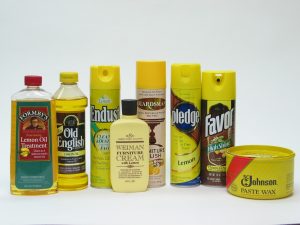We may receive a commission when you use our affiliate links. However, this does not impact our recommendations.

“Honey, will you call that furniture store and ask where the dipstick is on this table? I think it needs oil.” Cartoon by: Roger Huebner
I spent most of the decade of the ’90s trying to make sense of furniture polishes. Claims from manufacturers were (and still are) all over the map. Even worse were all the contradictory opinions of my professional-refinishing colleagues, museum conservators, furniture-store clerks and my customers.
I figured out pretty quickly that furniture polishes couldn’t possibly replace the natural oils in wood because only a few exotics, such as teak and rosewood, had natural oils (actually oily resins) to begin with. Almost all furniture woods contain water, not oil.
This claim by some manufacturers (and believed by many consumers) was even sillier when you consider that the primary purpose of a finish is to block liquids from getting to the wood.
I also figured out that furniture polishes couldn’t possibly “feed” a finish. With the exception of shellac, finishes are plastics (and shellac resembles plastic). To feed one of these plastics the furniture polish would have to penetrate it, which would mean soften it. This doesn’t happen, and it isn’t something you would want to happen.
Also, I knew that furniture polishes were rarely used, and in fact, not easily available, anywhere else in the world, except possibly in Canada. So they weren’t really needed, but they must have some positive qualities.
Slowly, I developed an organization and definitions (which I try to do with every subject) that made furniture polishes make sense. I concluded that furniture-care products do five things more or less well:
- add shine to dull surfaces
- add scratch resistance
- aid in dusting (by picking up the dust rather than spreading it around)
- aid in cleaning and
- adding a pleasant scent to a room.

These are common examples of the four categories of furniture polish. From the left: clear polishes, emulsion polishes, silicone polishes and paste wax.
Next I was able to separate furniture-care products into four groups: clear polishes, emulsion polishes, silicone polishes, and paste wax. Each group accomplishes the five things more or less well.
Clear polishes are petroleum distillates, essentially mineral spirits (paint thinner) that evaporates a little slower. These are good for cleaning grease or wax and for picking up dust. They are usually packaged in clear plastic containers. Their primary benefit is for dusting.
Emulsion polishes are a combination of petroleum-distillate solvent and water. They are milky-white in color. They clean water-soluble dirt in addition to grease and wax and are usually packaged in aerosols. Emulsion polishes are good for dusting and better for cleaning than clear polishes. (But cleaning is not often needed on furniture.)
Silicone polishes are clear or emulsion polishes with some silicone oil added. This oil is very slick and remains on the surface for a week or longer. This is how you identify these furniture polishes – by the smear you can cause with your finger days after application. Furniture polishes without silicone evaporate within hours. Silicone polishes add shine and reduce scratching in addition to dusting and maybe cleaning. These polishes are the most popular with consumers, by far, because they keep furniture looking rich and deep until the next dusting. Silicone polishes are also controversial, which I will discuss in another blog post.
Finally, there are paste waxes. These are more difficult to apply and can’t be used for dusting or cleaning but remain on the surface for months (unless removed by one of the furniture polishes). Use paste wax for a fairly permanent shine and scratch resistance, but keep in mind that you’ll then need to use a damp cloth, chamois, or some sort of duster for dusting rather than furniture polish.
— Bob Flexner
Editor’s note – You’ll find all of Bob’s books in our store: “Flexner on Finishing” and “Wood Finishing 101.”
Here are some supplies and tools we find essential in our everyday work around the shop. We may receive a commission from sales referred by our links; however, we have carefully selected these products for their usefulness and quality.









Bob, really appreciate your determination to de-mystify this stuff especially since I have a chem background. Usually find reading labels very frustrating. my question concerns a recent project where I applied two coats of Old Masters natural gel stain to a box made from reclaimed cedar decking. really like the way it brings out the natural deep reds in the wood without making it too dark. I looks so good that I am tempted to pass on a top coat although shellac works well and just wax the cured finish. I have some high quality wax that I soften a tad with mineral spirits and work it into the piece. Your thoughts?
much appreciated.
I have been using camellia oil on my guitar, hand rubbed into the wood, then wiped later with a Terry cloth. Any ideas if this is not a good idea?
Bob – always enjoy your commentary. I do have a question – you say furniture finishes are most always a plastic. A half dozen years ago, I toured the Thomas Moser plant in Auburn Maine. I watched as a chap spray on heated BLO – (steam heated in 55 gal drums). After spraying, excess was wiped off and the following day a 2nd coat was applied. On the 3rd day, the piece is polished using a carnuba wax.
Is BLO considered a plastic? Moser markets the product as a lifetime finish because it can be renewed without stripping. I would never think of using a furniture polish, but I would use a good wax to “temporarily renew” the surface. And a touch up with BLO occasionally (after the surface was cleaned and wax removed). Is this right? Help me out here in getting my thinking striaght.
Thanks!
Ed Gregg